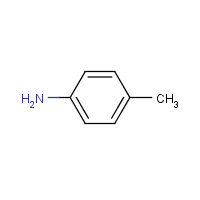p-Toluidine
Agent Name
p-Toluidine
CAS Number
106-49-0
Formula
C7-H9-N
Major Category
Nitrogen Compounds

Synonyms
1-Amino-4-methylbenzene; 4-Amino-1-methylbenzene; 4-Aminotoluen [Czech]; 4-Aminotoluene; 4-Methylaniline; 4-Methylbenzenamine; 4-Toluidine; Aniline, p-methyl-; Benzenamine, 4-methyl-; C.I. 37107; C.I. Azoic Coupling Component 107; CI 37107; CI Azoic Coupling Component 107; Naphtol AS-KG; Naphtol AS-KGLL; Toluidine, p-; p-Aminotoluene; p-Methylaniline; p-Methylbenzenamine; p-Toluidin [Czech]; p-Toluidyna [Polish]; p-Tolylamine; [ChemIDplus] UN1993
Category
Amines, Aromatic
Description
White solid with an aromatic odor. [Note: Used as a basis for many dyes.]; [NIOSH]
Sources/Uses
Intermediate used in the organic synthesis of dyes, reagents, and other chemicals; [ACGIH]
Comments
Solid form causes first degree burns on short exposure; [CHRIS] "In the United Kingdom between 1961 and 1980, chloroaniline, p-toluidine, nitrobenzene, and nitrochlorobenzene were the most common industrial causes of methemoglobinemia. Dermal exposure was a more frequent route of toxicity than inhalation with these compounds." [Ellenhorn, M.J. and D.G. Barceloux. Medical Toxicology - Diagnosis and Treatment of Human Poisoning. New York, NY: Elsevier Science Publishing Co., Inc. 1988.] Listed in the table "Examples of Industrial Chemicals for Which Methemoglobin Formation is NOT the Principal Cause of Toxicity"; [ACGIH] May cause methemoglobinemia and kidney injury; A potential skin sensitizer; [ICSC]
Biomedical References
Exposure Assessment
BEI
Methemoglobin in blood = 1.5% of hemoglobin during or at end of shift. [ACGIH]
Skin Designation (ACGIH)
Yes
TLV (ACGIH)
2 ppm
Vapor Pressure
0.286 mm Hg
Odor Threshold Low
0.02 ppm
Odor Threshold High
3.2 ppm
Lethal Concentration
LC50 (rat) > 640 mg/m3/1h
Explanatory Notes
Odor threshold from AIHA; Flash point = 87 deg C; VP from HSDB;
Reference Link #2
NFPA
high ambient temp required
Adverse Effects
Skin Sensitizer
Yes
Methemoglobinemia
MetHgb is secondary toxic effect
Dermatotoxin
Skin burns
ACGIH Carcinogen
Confirmed Animal
Diseases, Processes, and Activities Linked to This Agent
Diseases
Occupational diseases associated with exposure to this agent:
Activities
Activities with risk of exposure: